|
|
 ccording to tradition, Jesus walked along this road called Via Dolorosa, carrying a cross on his back, from the place that he was sentenced - where St. Stephan’s Gate stands today- to his crucifixion in Golgotha (Calvary) in the heart of the Christian Quarter of Jerusalem. ccording to tradition, Jesus walked along this road called Via Dolorosa, carrying a cross on his back, from the place that he was sentenced - where St. Stephan’s Gate stands today- to his crucifixion in Golgotha (Calvary) in the heart of the Christian Quarter of Jerusalem. |
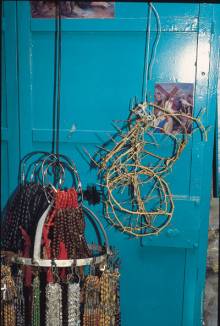
 Click to enlarge Click to enlarge
|
 n the days of the Roman empire a convicted person was forced to carry an agonizingly heavy cross, as a deterrent for all to see and fear. The 11.4 kilometer long Via Dolorosa, with the 14 stations of the Cross, passes through part of the Moslem Quarter and most of the Christian Quarter. Nine of the Stations are situated along the road, and the other five are inside the Church of the Holy Sepulchre. n the days of the Roman empire a convicted person was forced to carry an agonizingly heavy cross, as a deterrent for all to see and fear. The 11.4 kilometer long Via Dolorosa, with the 14 stations of the Cross, passes through part of the Moslem Quarter and most of the Christian Quarter. Nine of the Stations are situated along the road, and the other five are inside the Church of the Holy Sepulchre. |
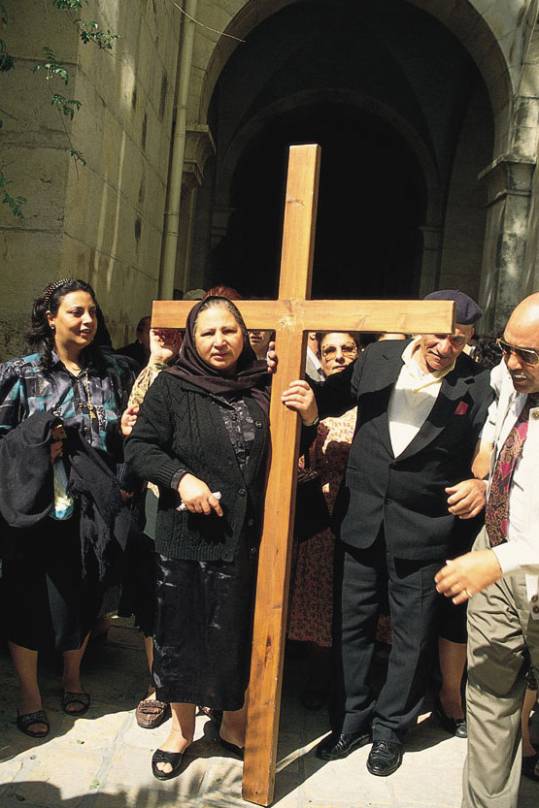 |
|
Luke 23:1-11
The whole assembly then rose, and they brought him before Pilate. They began their accusation by saying, ‘We found this man inciting our people to revolt, opposing payment of the tribute to Caesar, and claiming to be Christ, a king.’ Pilate put to him this question, ‘Are you the king of the Jews?’ ‘It is you who say it,’ he replied. Pilate then said to the chief priests and the crowd, ‘I find no case against this man.’ But they persisted, ‘He is inflaming the people with his teaching all over Judaea; it has come all the way from Galilee, where he started, down to here.’ When Pilate heard this, he asked if the man were a Galilean; and finding that he came under Herod’s jurisdiction he passed him over to Herod who was also in Jerusalem at that time.
Herod was delighted to see Jesus; he had heard about him and had been wanting for a long time to set eyes on him; moreover, he was hoping to see some miracle worked by him. So he questioned him at some length; but without getting any reply. Meanwhile the chief priests and the scribes were there, violently pressing their accusations. Then Herod, together with his guards, treated him with contempt and made fun of him; he put a rich cloak on him and sent him back to Pilate.
John 19:1-6
Pilate then had Jesus taken away and scourged; and after this, the soldiers twisted some thorns into a crown and put it on his head, and dressed him in a purple robe. They kept coming up to him and saying, ‘Hail, king of the Jews!’; and they slapped him in the face. Pilate came outside again and said to them, ‘Look, I am going to bring him out to you to let you see that I find no case.’ Jesus then came out wearing the crown of thorns and the purple robe. Pilate said, “Here is the man.’ When they saw him the chief priests and the guards shouted, ‘Crucify him! Crucify him!’ Pilate said, ‘Take him yourselves and crucify him: I can find no case against him.’
|
|
The First Station
 he Praetorium he Praetorium
Mark 15:16
The soldiers led him away to the inner part of the palace, that is, the Praetorium, and called the whole court together.
 t the site where the inner court (the Praetorium - part of the Antonia Fortress) stood in Roman times, there stands a Turkish building which is the Omariyya School today. The structure is located north of and adjacent to the Temple Mount. It is identified with the Antonia Fortress (of Second Temple days) where reserve Roman soldiers were stationed, mainly on holidays, to stifle potential rebellious activity that might occur due to the convergence of so many pilgrims visiting the city. This explains the presence of the Roman consul Pontius Pilate in the Praetorium of the fortress during the Passover festival (when Jesus was arrested). Pilgrims identify the arch named ‘Ecce Homo,’ which stands west of today’s marketplace, with the gate of the Antonia Fortress. This is the place where Pilate presented Jesus before the masses and said, ‘Behold the man.’ For centuries, Franciscan monks in Jerusalem have held processions following the 14 Stations every Friday at 3:00 p.m., starting at the Omariyya School's courtyard. t the site where the inner court (the Praetorium - part of the Antonia Fortress) stood in Roman times, there stands a Turkish building which is the Omariyya School today. The structure is located north of and adjacent to the Temple Mount. It is identified with the Antonia Fortress (of Second Temple days) where reserve Roman soldiers were stationed, mainly on holidays, to stifle potential rebellious activity that might occur due to the convergence of so many pilgrims visiting the city. This explains the presence of the Roman consul Pontius Pilate in the Praetorium of the fortress during the Passover festival (when Jesus was arrested). Pilgrims identify the arch named ‘Ecce Homo,’ which stands west of today’s marketplace, with the gate of the Antonia Fortress. This is the place where Pilate presented Jesus before the masses and said, ‘Behold the man.’ For centuries, Franciscan monks in Jerusalem have held processions following the 14 Stations every Friday at 3:00 p.m., starting at the Omariyya School's courtyard.
|
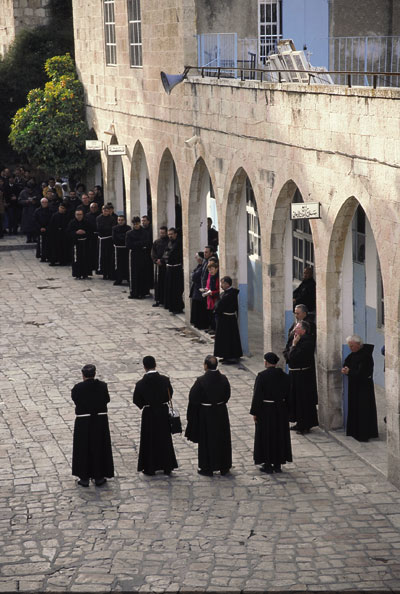 |
| The courtyard of Omariyya School - The First Station. |
|
Mark 15:1-20
First thing in the morning, the chief priests together with the elders and scribes, in short the whole Sanhedrin, had their plan ready. They had Jesus bound and took him away and handed him over to Pilate. Pilate questioned him, ‘Are you the king of the Jews?’ ‘It is you who say it,’ he answered. And the chief priests brought many accusations against him. Pilate questioned him again, ‘Have you no reply at all? See how many accusations they are bringing against you!’ But, to Pilate’s amazement, Jesus made no further reply. At festival time Pilate used to release a prisoner for them, anyone they asked for. Now a man called Barabbas was then in prison with the rioters who had committed murder during the uprising. When the crowd went up and began to ask Pilate the customary favor, Pilate answered them, ‘Do you want me to release for you the king of the Jews?’ For he realized it was out of jealousy that the chief priests had handed Jesus over. The chief priests, however had incited the crowd to demand that he should release Barabbas for them instead. Then Pilate spoke again. ‘But in that case,’ he said to them ‘what am I to do with the man you call king of the Jews?’ The shouted back, ‘Crucify him!’ ‘Why?’ Pilate asked them, ‘What harm has he done?’ But they shouted all the louder, ‘Crucify him!’ So Pilate, anxious to placate the crowd, released Barabbas for them and, having ordered Jesus to be scourged, handed him over to be crucified. Reference also Matthew 27:11-31, Luke 23:1-25, John 18:29-40, John 19:1-15 John 18:33-40
So Pilate went back into the Praetorium and called Jesus to him, ‘Are you the king of the Jews?’ he asked. Jesus replied, ‘Do you ask this of your own accord, or have others spoken to you about me?’ Pilate answered, ‘Am I a Jew? It is your own people and the chief priests who have handed you over to me: what have you done?’ Jesus replied, ‘Mine is not a kingdom of this world; if my kingdom were of this world, my men would have fought to prevent my being surrendered to the Jews. But my kingdom is not of this kind.’ ‘So you are a king then?’ said Pilate. ‘It is you who say it,’ answered Jesus. ‘Yes, I am a king. I was born for this, I came into the world for this: to bear witness to the truth; and all who are on the side of truth listen to my voice.’ ‘Truth?’ said Pilate ‘What is that?’; and with that he went out again to the Jews and said, ‘I find no case against him. But according to a custom of yours I should release one prisoner at the Passover; would you like me, then, to release the king of the Jews?’ At his they shouted: ‘Not this man,’ they said ‘but Barabbas.’ Barabbas was a brigand.
|
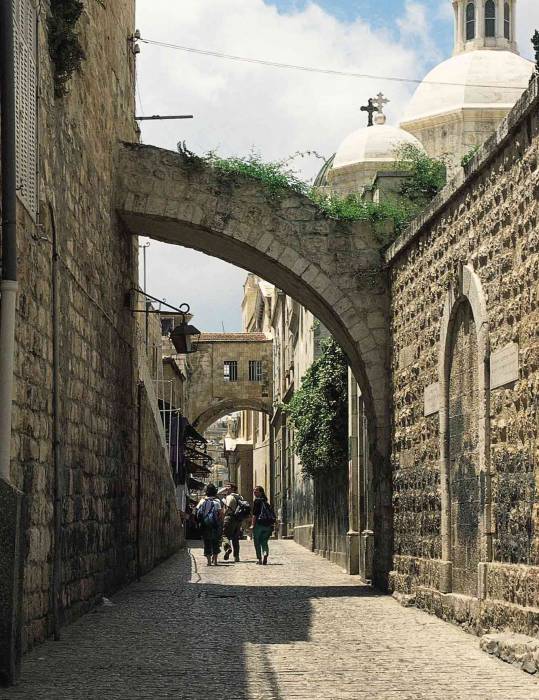 |
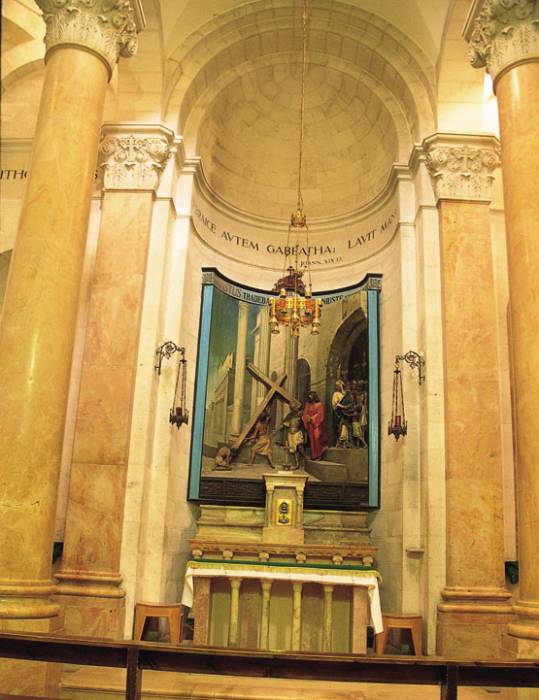 |
|
Fifth Station
 hapel of Simon of Cyrene hapel of Simon of Cyrene
The Franciscan Chapel of Simon of Cyrene was built in 1895. According to tradition, this is the place where Simon of Cyrene was compelled by Roman soldiers to assist Jesus in carrying the cross. Simon was a pilgrim from North Africa who had come to Jerusalem for Passover. On the right side of the entrance to the chapel is a rock with an indentation, which many believe was made when Jesus leaned on it with his hand.
|
|
Seventh Station
 esus Falls for the Second Time esus Falls for the Second Time
The Seventh Station marks the place where Jesus passed through the Gate of Judgment, along the streets of Jerusalem on his way to Golgotha. Inside the lower chapel is a pillar, part of the late Roman Cardo colonnade.
Eighth Station
 esus Speaks to the Daughters of Jerusalem esus Speaks to the Daughters of Jerusalem
This station, outside the city limits of the Second Temple, was in an open field where Jesus met the daughters of Jerusalem who were crying over his bitter fate. His answer to them was ‘Daughters of Jerusalem, do not weep for me; weep rather for yourselves and for your children.’ Luke 23:28. Later on, Jesus prophesied the destruction of the Second Temple. This Station is marked by a stone in a wall inscribed with a cross and the Latin words, “Jesus Christ is Triumphant.”
Ninth Station
 esus Falls for the Third Time esus Falls for the Third Time
Situated at the entrance to the Coptic Church, here the exhausted Jesus faltered again under the burden of the cross.
|
| Eighth Station of the Cross. |
|
|

